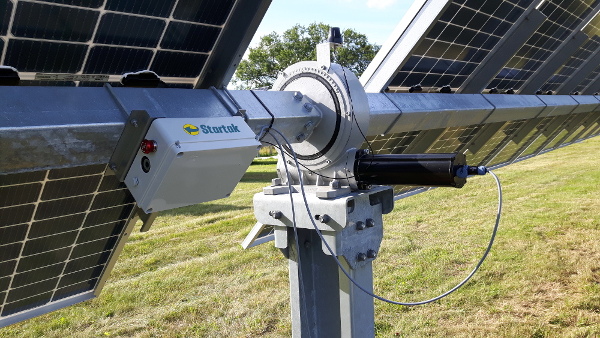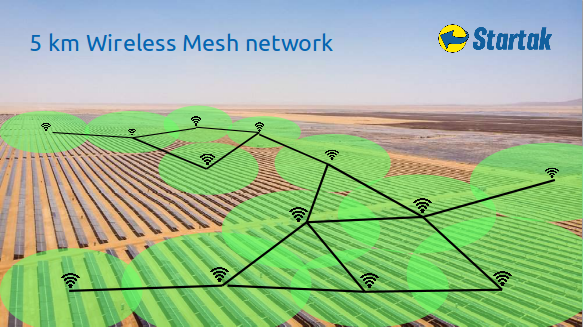
Our technology is the result of over 15 years of work in the field of solar tracking. We have been leading European and Danish funded innovation project, in collaboration with EPCs, solar tracker manufacturers and research centers, which lead to the development of our unique solutions. We continuously look for ways to improve our Sun tracking systems so that they can offer to our customers higher performance, easier operation and lower cost.
Web based SCADA
Our supervision, control and data acquisition system is entirely web based, which means that you don’t need to install any software or pay any license to use it. The webserver run on each Sun Position Server (SPS), and you can access the graphical user interface with a simple web browser.
Wireless mesh communication
 All our devices communicate via a wireless mesh network that we developed. Our wireless mesh network provides a self-forming and self-healing network, with ease of deployment. The network topology can scale up to 200 nodes in large areas, without requiring any specific Wi-Fi infrastructure support. Startak-mesh is based on standard Wi-Fi connectivity and it can use standard WPA2 network security among the mesh nodes to ensure communication security.
All our devices communicate via a wireless mesh network that we developed. Our wireless mesh network provides a self-forming and self-healing network, with ease of deployment. The network topology can scale up to 200 nodes in large areas, without requiring any specific Wi-Fi infrastructure support. Startak-mesh is based on standard Wi-Fi connectivity and it can use standard WPA2 network security among the mesh nodes to ensure communication security.
The Sun position server bridge the Startak-mesh network to the WiFi/ethernet IP network of the customer and periodically send the data collected from solar trackers and meteo stations to the cloud database.
Power options
Our tracker control unit (TCU) can be provided in three versions:
Self powered: this solution is meant to drive 24 Vdc brushed motors with the energy produced by a stand alone small photovoltaic panel, which is used to charge a lithium battery. We have developed a particular charging circuit which tracks the maximum power point (MPPT) of the solar panel and charge the battery with high efficiency. The battery state of charge is constantly monitored, and the tracker is positioned in the pre-set safe position in case the battery state of charge is too low.
Grid powered: in this case the power for the 24 Vdc brushed motor comes from a switching power supply that transform the input 230 V ac to 24 Vdc. This solution requires therefore the installation of a 230 Vac cable to each solar tracker, but at the same time the TCU is cheaper, as there is no battery and no small photovoltaic panel.
Grid powered for AC motors: this version of the TCU is designed to control single phase induction motors. This motors typically have two armatures, which allow to rotate forward or reverse. As the input and output voltage are equal, there is no need for the switching power supply, therefore this TCU is even cheaper and reliable than the previous.
Actuators
Our Sun tracking control systems allow to connect virtually any type of actuator and in particular:
- DC brushed motors
- DC brush-less motors
- AC induction motors, single phase and three phase.
- Electric motors with inverter.
- Hydraulic cylinders.
- Servo motors.
Tracking strategy
There are two approaches to follow the Sun: calculating the best tracker position based on time and location, or by using sensors that measure the Sun position. We can offer both.
In the case of a calculated Sun position, which is common for large solar plants, we use the Sun Position Algorithm developed by NREL which provides an accuracy of 0.00003°, in combination with our software to define the best tracker position based on the Sun position.
Tracking with a light optimization strategy we use sensors developed by us in collaboration with the Technical University o Denmark. We have two axis digital light direction sensors with 0.003° resolution, and special sensors to optimize the position of bifacial solar panels.
Back tracking
Wind speed protection
![]() Wind speed monitoring is especially important in plants with solar trackers, that is why our tracking systems are available with various configurations for wind speed protection. As a minimum you should use one of our meteo stations, which includes:
Wind speed monitoring is especially important in plants with solar trackers, that is why our tracking systems are available with various configurations for wind speed protection. As a minimum you should use one of our meteo stations, which includes:
- High speed input for pulse anemometer.
- Analog input for wind vane.
- RS232 input/output for snow height sensor or sonic anemometer.
- Wireless mesh communication.
- Display where you can see several operation parameters such as gust wind speed (3s average), 10 minutes average wind speed, wind direction, status of the wind alarm function.
The wind alarm function is fully configurable via web. If the wind vane is used, the tracker will stow at the desired angle depending on wind direction. In case of lost communication with the meteo station, the solar tracker will move to the programmed safe position in the programmed time. This makes the wind speed protection system fail safe.
Sensors
Sensors are an important component in the functioning of our Sun tracking systems. Time has allowed us to select those sensors with the necessary features to ensure durability in the environment of the solar plant. This means resistance to intense Sun light, extreme temperature variations and rain/humidity.
- Wind speed
- Wind direction
- Snow height
- Rain
- Sun radiation
- Sun light direction (two axis)
- Multi direction light (to optimize bifacial photovoltaic)
- Inclination (using accelerometers)
Certifications
- Low voltage directive (LVD) (2014/35/EU)
- EMC directive (2014/30/EU)